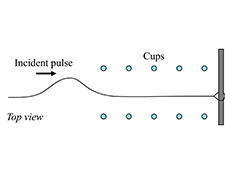
Superposition of pulses
Variant i Interactive tutorial lecture Other Variants Dynamics first
Students use superposition to determine the overall shape of a spring while two pulses overlap. They then develop a model for how pulses behave after reaching a fixed and free end.
Topics Waves and optics / Waves: boundary conditions, models, superposition, symmetry, fixed end reflection, free end reflection, linear mass density, pulses on springs, tension, wave (or pulse) speed, and superposition
Materials
Materials by the UW team
- Clicker Questions Only


- Instructor Guide


- Pretest



- Pretest for LMS



- Exam Questions



- Equipment List

Tutorial details
Section I: Properties of pulses
This section involves a series of video observations of pulses traveling along a spring. From the first video, students recognize that the amplitude, width, shape, and speed of a pulse do not change significantly as the pulse travels.
In the video that follows, students observe how the speed of the pulse is affected when the (1) pulse amplitude, (2) pulse width, and (3) spring tension are changed. From these observations, students infer that the speed of a pulse depends on the medium through which it travels rather than on the features of the pulse itself.
Section II: Superposition
Students examine two time sequences of photographs in which two pulses on a spring approach one another. In the first case, the pulses are on the same side of the spring; in the second, the pulses are on opposite sides of the spring. Students are led to recognize that the principle of superposition can be used to determine the overall shape of the spring.
Section III: Reflection from a fixed end
Students examine a time sequence of photographs that depict the reflection of a pulse from a fixed end. They are led to recognize the similarity between (1) reflection by a fixed end and (2) superposition of two pulses on opposite sides of a spring that approach each other. This similarity motivates a model for reflection from a fixed end: we can treat the spring as if it extends beyond the fixed end and imagine the pulse incident on the fixed end is met by a pulse passing the other way so that the end of the spring remains stationary. Students use this model to determine the shape of a spring while an asymmetric pulse is being reflected.
Section IV: Reflection from a free end
Students are presented a scenario in which a pulse is sent along a spring toward a free end. The spring is surrounded by cups placed along the floor. Students predict which cups, if any, are knocked down during the reflection, then observe a video demonstration.
The video demonstration in this section is necessary for the homework.
For instruction tips, login or register as a verified educator to see the Instructor Guide.
Prerequisites
Students should have previously studied basic kinematics and the principle of superposition.
Equipment
Special Instructions
If, after the interactive tutorial lecture, students need access to the videos showing the results of the experiments in this tutorial, they can find them at these links: https://www.youtube.com/watch?v=ka7tDwfKaG8, https://youtu.be/nfksFCmrzHo, https://youtu.be/1uibf6dh_XU.
List
- tutorial instructor slides
- tutorial student slides or worksheet
Resources and Links
https://www.youtube.com/watch?v=ka7tDwfKaG8, https://youtu.be/nfksFCmrzHo, https://youtu.be/1uibf6dh_XU
Research
- M. Kryjevskaia, M. R. Stetzer, and P. R. L. Heron, Student understanding of wave behavior at a boundary: The limiting case of reflection at fixed and free ends, 79 (5) 508-516 (2011).
Coming Soon! We hope to release the discussion section on each tutorial soon.

